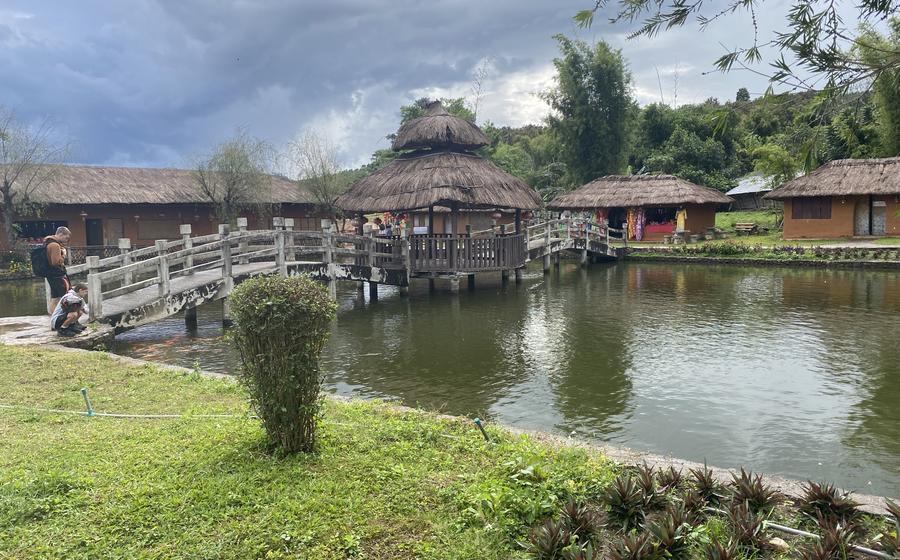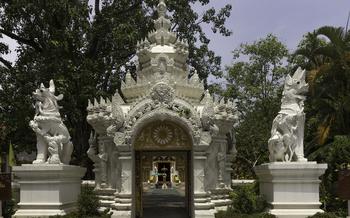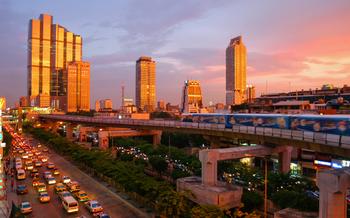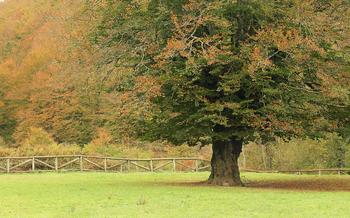
Santichon Village (Chinese Village)
- Historical Background
- Architectural Heritage
- Community Life
- Local Cuisine
- Shopping
- Temples and Shrines
- Festivals and Events
- Getting There
- Accommodation
- Things to Do Nearby
- Photography Opportunities
- Volunteering Opportunities
- Food Tours
- Cultural Workshops
- Insider Tip
Historical Background
Pai's history is closely entwined with the arrival of the Chinese community in the late 19th century. During that period, many Chinese laborers migrated to Thailand to work in the tin mines and teak industry. Some of these migrants eventually settled in Pai, where they established a small but vibrant community.
The founding of Santichon Village, also known as the Chinese Village, can be traced back to the early 1900s. As the Chinese community in Pai grew, they felt the need to create a dedicated space where they could preserve their cultural heritage and traditions. Thus, they established Santichon Village, which quickly became the heart of the Chinese community in Pai.
The village's architecture and way of life have been heavily influenced by Chinese culture. The traditional Chinese-style buildings, ornate temples, and shrines are a testament to the strong Chinese influence in the village. Additionally, many of the village's customs and practices, such as the celebration of Chinese New Year, have been passed down from generation to generation.
Architectural Heritage
Santichon Village showcases a harmonious blend of traditional Chinese architectural styles with influences from the Lanna culture of northern Thailand. Many of the buildings within the village feature intricate carvings, colorful motifs, and sloping roofs that are reminiscent of temples and palaces in China. The village's streets are lined with well-preserved wooden shop houses, each adorned with red lanterns and Chinese characters, creating a vibrant and visually captivating atmosphere.
One of the village's most striking architectural landmarks is the San Payap Temple, which boasts a stunning red and gold façade, elaborate carvings, and a towering steeple that dominates the village's skyline. Other notable buildings include the Guan Di Temple, dedicated to the Chinese god of war, and the Chinese School, which was established in 1940 to preserve and promote Chinese language and culture among the village's residents.
While the village retains its distinctly Chinese character, it also exhibits subtle influences from the local Lanna culture. This is evident in the use of teak wood in construction, the incorporation of Lanna-style motifs in the carvings, and the vibrant colors that adorn the buildings. This unique fusion of architectural styles creates a visually rich and captivating environment that is unlike anything else found in Thailand.
Community Life
Santichon Village is a vibrant community where the residents share a strong sense of belonging and togetherness. The village's traditions and customs have been passed down from generation to generation and are still observed today. Elders play an important role in preserving the village's cultural heritage by passing on their knowledge and traditions to younger generations.
They are respected figures in the community and are often consulted for advice on important matters. The sense of community is evident in the way the residents interact with each other. They are always willing to help each other out, and there is a strong spirit of cooperation and mutual respect.
Visitors to the village are often struck by the warmth and hospitality of the residents, who are always happy to welcome newcomers and share their culture. The village's strong sense of community is one of its most endearing qualities and is a key part of what makes it such a special place to visit.
Local Cuisine
Santichon Village is a paradise for food lovers, offering a delectable array of authentic Chinese dishes that will tantalize your taste buds. The village's restaurants serve up a variety of traditional favorites, such as dim sum, noodles, and stir-fries, all prepared with fresh ingredients and mouthwatering flavors.
Must-try Dishes:
- Khao Soi: A northern Thai curry noodle soup made with a rich coconut milk-based broth, egg noodles, and a variety of toppings such as chicken, beef, or tofu.
- Pad Thai: A stir-fried rice noodle dish with eggs, vegetables, and a sweet and tangy tamarind sauce.
- Som Tum: A spicy green papaya salad made with unripe papaya, tomatoes, garlic, chili peppers, and lime juice.
- Gaeng Daeng: A red curry dish made with chicken or pork, bamboo shoots, and kaffir lime leaves.
- Massaman Curry: A southern Thai curry dish made with beef or chicken, potatoes, peanuts, and a blend of spices.
For those who want to learn the secrets behind these delicious dishes, cooking classes and workshops are available in the village. These classes offer a hands-on experience, allowing visitors to learn how to prepare traditional Chinese dishes from scratch.
Whether you're a seasoned foodie or simply looking for a taste of authentic Chinese cuisine, Santichon Village has something to offer everyone. So come hungry and prepare to indulge in a culinary adventure like no other!
Shopping
Amidst the charming streets of Santichon Village, visitors will discover a treasure trove of shops brimming with authentic Chinese handicrafts and unique souvenirs. From intricate porcelain figurines to colorful silk scarves, there's something to suit every taste and budget. One must-have item is the traditional Chinese tea set, known for its delicate craftsmanship and exquisite designs. Whether you're a tea connoisseur or simply looking for a thoughtful gift, a tea set from Santichon Village is sure to impress.
For those seeking one-of-a-kind items, the village's shops offer a range of handmade goods that are not easily found elsewhere in Thailand. From intricately carved wooden sculptures to hand-painted lanterns, these unique creations showcase the skill and artistry of local craftsmen. Bargaining is a customary part of the shopping experience in Santichon Village, and visitors are encouraged to engage in friendly negotiations to secure the best prices. With a little patience and charm, you're sure to walk away with some amazing finds without breaking the bank.
Temples and Shrines
Santichon Village is home to several beautiful temples and shrines, each with its own unique cultural and religious significance. The most prominent of these is the Santichon Temple, which serves as the spiritual center of the village. The temple features intricate carvings, colorful murals, and a serene atmosphere that invites contemplation and reflection.
Other notable temples in the village include the Guan Yu Temple, dedicated to the Chinese god of war, and the Wenchang Temple, which is dedicated to the god of literature and education. These temples are popular pilgrimage sites for both locals and visitors, and offer a glimpse into the deep-rooted Chinese beliefs and traditions that shape the community's identity.
When visiting the temples, it is important to observe proper etiquette and customs. Visitors should dress modestly, remove their shoes before entering the temple, and refrain from talking loudly or taking photos without permission. By showing respect for the sacred spaces, visitors can contribute to the preservation of the village's rich cultural heritage.
Festivals and Events
Chinese New Year is the most important festival celebrated in Santichon Village. The village comes alive with decorations, music, and festivities during this time. Lion dances, fireworks, and traditional performances fill the streets as the community celebrates the start of the new year. Visitors can witness the vibrant Chinese New Year parade and enjoy the lively atmosphere of the village during this special occasion.
Throughout the year, Santichon Village also hosts several other festivals and events that showcase Chinese culture and traditions. These events include the Mid-Autumn Festival, the Dragon Boat Festival, and the Vegetarian Festival. Visitors can immerse themselves in the rich cultural heritage of the village by attending these festivals, sampling the delicious food offerings, and participating in the various activities and performances.
Getting There
Reaching Pai from major cities in Thailand is a relatively straightforward process. Several transportation options are available, including buses, trains, and flights. Buses are the most economical option and depart from various cities, including Chiang Mai, Bangkok, and Phuket. The journey takes approximately 6-8 hours, depending on the departure point. Trains are a more scenic option, but they are also slower and less frequent. Flights to Pai are available from Chiang Mai and Bangkok, offering the fastest and most convenient option, but they tend to be more expensive.
Once in Pai, the best way to explore Santichon Village is on foot. The village's narrow streets are not accessible to cars, so walking is the best way to immerse yourself in the local atmosphere and admire the unique architecture up close. Several parking facilities are available on the outskirts of the village for those arriving by car.
Accommodation
Pai offers a diverse range of accommodation options to suit every budget and preference, from charming guesthouses to luxurious resorts. For those seeking an authentic experience, several guesthouses are located within Santichon Village itself, allowing visitors to immerse themselves fully in the village's unique atmosphere. These guesthouses typically offer basic but comfortable rooms with shared or private bathrooms.
For a more upscale stay, several hotels and resorts are situated just a short walk from the village. These establishments provide modern amenities such as air conditioning, private balconies, and swimming pools. Many also incorporate traditional Chinese elements into their design, creating a harmonious blend of modern comfort and cultural heritage.
When booking accommodation in Pai, it's advisable to do so well in advance, especially during peak season (November to February) when the village sees an influx of tourists. Online booking platforms offer a convenient way to compare prices and availability across different properties.
Here are some recommended hotels and guesthouses near Santichon Village:
- The White House Hotel Pai: A charming hotel located just steps from the village, offering cozy rooms with balconies overlooking the surrounding mountains.
- The Yun Lai Viewpoint Resort: A peaceful resort situated on a hilltop, providing stunning views of Pai and the surrounding countryside.
- Santichon Village Guesthouse: A family-run guesthouse within the village, offering basic but comfortable rooms with shared bathrooms.
Whether you choose to stay in the heart of Santichon Village or in one of the nearby hotels, you'll find a range of options to suit your needs and budget.
Things to Do Nearby
While in Pai, there's a wealth of additional attractions and activities to explore beyond Santichon Village. Pai Canyon offers breathtaking views of the surrounding landscape and is a popular spot for hiking and photography. The Pai Hot Springs provide a relaxing and rejuvenating experience, with natural hot springs set amidst lush greenery. For those seeking adventure, white water rafting and jungle trekking excursions are available, allowing visitors to immerse themselves in the region's natural beauty.
Pai is also a great base for exploring the surrounding areas. The Tham Lod Caves are a must-visit, with their impressive stalactites and stalagmites, and can be reached by a short boat ride. The Mae Hong Son Loop is a scenic motorcycle route that takes riders through stunning mountain scenery and traditional hill tribe villages. For a unique experience, visitors can take a bamboo rafting trip down the Pai River, offering a tranquil and immersive way to explore the local environment.
When planning your itinerary, consider the time of year you'll be visiting. Pai's annual Chinese New Year celebrations are a highlight, with colorful parades, lion dances, and traditional performances filling the streets. Other festivals throughout the year include the Strawberry Festival and the Pai Music Festival, each offering a unique opportunity to experience the town's vibrant culture.
Photography Opportunities
Santichon Village is a photographer's paradise, with its colorful buildings, intricate temples, and vibrant street life providing endless opportunities for capturing stunning images.
-
Scenic Spots: The best places to take photos in the village include the main street, which is lined with traditional Chinese architecture, and the village's temples and shrines, which are adorned with intricate carvings and colorful decorations.
-
Tips for Taking Photos: Use a wide-angle lens to capture the scale and grandeur of the village's architecture. Experiment with different angles and perspectives to create unique and interesting compositions. Take advantage of the natural light, which is often best in the early morning or late afternoon.
-
Photo Tours and Workshops: For those who want to improve their photography skills, several photo tours and workshops are available in Pai. These tours typically take participants to the village's most photogenic spots and provide guidance on composition, lighting, and camera settings. Workshops often include hands-on instruction and feedback from experienced photographers.
Volunteering Opportunities
Santichon Village welcomes volunteers who are passionate about preserving Chinese culture and giving back to the community. There are several opportunities for volunteers to get involved in various projects, such as teaching English to local children, assisting with community development initiatives, or helping with temple renovations. Volunteers can choose the duration of their stay, from a few weeks to several months, depending on their availability and interests.
Volunteering in Santichon Village is a rewarding experience that allows visitors to immerse themselves in Chinese culture while making a positive impact on the community. Volunteers will have the chance to interact with the villagers, learn about their traditions, and contribute to the preservation of their unique heritage.
Here are some tips for finding volunteer placements in Santichon Village:
-
Contact local organizations: Reach out to local NGOs or community groups that work with volunteers in the village. They can provide information about current volunteer opportunities and help you find a placement that matches your interests and skills.
-
Inquire at the village temple: The village temple is often involved in community development projects and may have volunteer opportunities available. You can visit the temple and inquire about any volunteer positions they might have.
-
Ask around the village: Talk to the villagers and ask if they know of any volunteer opportunities. The villagers are friendly and welcoming and may be able to connect you with local organizations or individuals who need volunteers.
Food Tours
Indulge in a Culinary Adventure with Santichon Village's Food Tours
Embark on a tantalizing journey through the flavors of Santichon Village with a guided food tour. These culinary experiences offer an immersive exploration of the village's rich Chinese cuisine, taking you to the best restaurants and hidden gems where locals dine.
Must-Try Dishes:
-
Khao Soi: A flavorful northern Thai curry noodle soup with tender chicken or beef, served with crispy egg noodles and a variety of toppings.
-
Sai Ua: A traditional northern Thai sausage made with minced pork, herbs, and spices, grilled to perfection.
-
Khanom Jeen Nam Ngiao: Fermented rice noodles served with a spicy pork and tomato sauce, topped with crispy shallots and peanuts.
-
Nam Prik Ong: A spicy chili paste made with roasted chili peppers, tomatoes, and garlic, served with fresh vegetables for dipping.
-
Khanom Wan: Steamed rice cakes filled with sweet mung bean paste, a popular dessert in the village.
Tips for Choosing a Food Tour Operator:
-
Look for reputable tour operators: Read reviews and recommendations from other travelers to find a reliable and experienced food tour company.
-
Choose a tour that suits your preferences: Some tours focus on specific cuisines or dietary restrictions, so choose one that matches your interests.
-
Consider the group size: Smaller groups often offer a more personalized experience and allow for more interaction with the guide.
-
Book in advance: Food tours can be popular, especially during peak season, so make sure to reserve your spot in advance to avoid disappointment.
Cultural Workshops
Santichon Village offers a unique opportunity to immerse yourself in Chinese culture and learn about its rich traditions through cultural workshops. These workshops are conducted by local experts who share their knowledge and insights on various aspects of Chinese culture, such as calligraphy, Chinese cooking, traditional Chinese medicine, and martial arts.
Calligraphy workshops introduce participants to the art of Chinese calligraphy, teaching them the basic strokes, techniques, and characters. Participants can practice writing their own names or Chinese phrases under the guidance of experienced calligraphers.
Chinese cooking workshops provide hands-on experience in preparing authentic Chinese dishes. Participants learn about the ingredients, cooking methods, and cultural significance of various Chinese dishes. They get to cook their own dishes under the guidance of local chefs and enjoy the fruits of their labor at the end of the workshop.
Traditional Chinese medicine workshops offer an introduction to the principles and practices of traditional Chinese medicine, including acupuncture, herbal medicine, and massage. Participants learn about the different types of herbs used in traditional Chinese medicine and their therapeutic properties. They may also get to experience acupuncture or massage treatments.
Martial arts workshops teach participants the basics of Chinese martial arts, such as Tai Chi, Kung Fu, and Wushu. These workshops provide an opportunity to learn about the history, philosophy, and techniques of Chinese martial arts. Participants get to practice basic forms and movements under the guidance of experienced instructors.
To find and book cultural workshops in Santichon Village, you can inquire at your hotel or guesthouse, visit the village's tourist information center, or search online for reputable tour operators that offer cultural experiences. Many workshops can be customized to suit your interests and skill level, and some even offer private classes for a more personalized learning experience.
Insider Tip
As you delve deeper into Santichon's rich tapestry, you'll discover a hidden gem nestled amidst its enchanting alleys: the "Chinese Herbal Tea Shop." This unassuming establishment is a treasure trove of aromatic teas, each carefully crafted using ancient Chinese recipes. Indulge in the soothing flavors of chrysanthemum, goji berry, or ginseng tea, and let the healing properties revitalize your body and soul. Embrace the opportunity to engage with the friendly locals, who will gladly share stories and insights into the village's fascinating history as you sip your tea.
For a truly immersive experience, venture off the beaten path and explore Santichon's hidden nooks and crannies. Discover secluded temples adorned with intricate carvings, stumble upon charming courtyards where locals gather for leisurely chats, and marvel at the vibrant street art that adorns the village walls. Immerse yourself in the vibrant local market, where you can haggle for unique souvenirs and sample exotic fruits and delicacies.
To truly immerse yourself in the local culture, consider purchasing a one-of-a-kind souvenir from Santichon Village. From intricate Chinese handicrafts to hand-painted ceramics, there's something for every taste and budget. Don't forget to haggle with the friendly vendors to secure the best prices. Remember, bargaining is a way of life in Thailand, and it's all part of the fun.
As you bid farewell to this enchanting village, take a moment to reflect on the unforgettable experiences you've had. Santichon Village is more than just a tourist destination; it's a living, breathing community that warmly welcomes visitors with open arms. Embrace the opportunity to connect with the locals, learn about their unique culture, and create memories that will last a lifetime.







